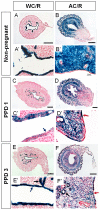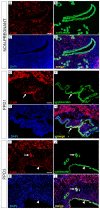Stromal-to-epithelial transition during postpartum endometrial regeneration
- PMID: 22970108
- PMCID: PMC3433810
- DOI: 10.1371/journal.pone.0044285
Stromal-to-epithelial transition during postpartum endometrial regeneration
Abstract
Endometrium is the inner lining of the uterus which is composed of epithelial and stromal tissue compartments enclosed by the two smooth muscle layers of the myometrium. In women, much of the endometrium is shed and regenerated each month during the menstrual cycle. Endometrial regeneration also occurs after parturition. The cellular mechanisms that regulate endometrial regeneration are still poorly understood. Using genetic fate-mapping in the mouse, we found that the epithelial compartment of the endometrium maintains its epithelial identity during the estrous cycle and postpartum regeneration. However, whereas the stromal compartment maintains its identity during homeostatic cycling, after parturition a subset of stromal cells differentiates into epithelium that is subsequently maintained. These findings identify potential progenitor cells within the endometrial stromal compartment that produce long-term epithelial tissue during postpartum endometrial regeneration.
Conflict of interest statement
Figures




Similar articles
-
Mesenchymal-to-epithelial transition contributes to endometrial regeneration following natural and artificial decidualization.Stem Cells Dev. 2013 Mar 15;22(6):964-74. doi: 10.1089/scd.2012.0435. Epub 2013 Jan 29. Stem Cells Dev. 2013. PMID: 23216285 Free PMC article.
-
The mouse endometrium contains epithelial, endothelial and leucocyte populations expressing the stem cell marker telomerase reverse transcriptase.Mol Hum Reprod. 2016 Apr;22(4):272-84. doi: 10.1093/molehr/gav076. Epub 2016 Jan 5. Mol Hum Reprod. 2016. PMID: 26740067 Free PMC article.
-
Identification of label-retaining cells in mouse endometrium.Stem Cells. 2006 Jun;24(6):1529-38. doi: 10.1634/stemcells.2005-0411. Epub 2006 Feb 2. Stem Cells. 2006. PMID: 16456137
-
Somatic stem cells in the endometrium.Reprod Sci. 2009 Feb;16(2):200-5. doi: 10.1177/1933719108329955. Reprod Sci. 2009. PMID: 19208788 Review.
-
The role of mesenchymal-epithelial transition in endometrial function.Hum Reprod Update. 2019 Jan 1;25(1):114-133. doi: 10.1093/humupd/dmy035. Hum Reprod Update. 2019. PMID: 30407544 Review.
Cited by
-
Mesenchymal-to-epithelial transition contributes to endometrial regeneration following natural and artificial decidualization.Stem Cells Dev. 2013 Mar 15;22(6):964-74. doi: 10.1089/scd.2012.0435. Epub 2013 Jan 29. Stem Cells Dev. 2013. PMID: 23216285 Free PMC article.
-
Novel microarchitecture of human endometrial glands: implications in endometrial regeneration and pathologies.Hum Reprod Update. 2022 Feb 28;28(2):153-171. doi: 10.1093/humupd/dmab039. Hum Reprod Update. 2022. PMID: 34875046 Free PMC article. Review.
-
Regulation of Cyclic AMP-Response Element Binding Protein Zhangfei (CREBZF) Expression by Estrogen in Mouse Uterus.Dev Reprod. 2018 Mar;22(1):95-104. doi: 10.12717/DR.2018.22.1.095. Epub 2018 Mar 31. Dev Reprod. 2018. PMID: 29707688 Free PMC article.
-
Integrated analysis of endometrial stromal cell long noncoding RNA and mRNA expression profiles associated with TGF-β1-induced fibrosis.Acta Biochim Biophys Sin (Shanghai). 2024 Jun 25;56(6):952-955. doi: 10.3724/abbs.2024052. Acta Biochim Biophys Sin (Shanghai). 2024. PMID: 38639033 Free PMC article. No abstract available.
-
Inside the Endometrial Cell Signaling Subway: Mind the Gap(s).Int J Mol Sci. 2018 Aug 21;19(9):2477. doi: 10.3390/ijms19092477. Int J Mol Sci. 2018. PMID: 30134622 Free PMC article. Review.
References
-
- Roy A, Matzuk MM (2011) Reproductive tract function and dysfunction in women. Nat Rev Endocrinol 7: 517–525. - PubMed
-
- Bulun SE (2010) Endometriosis. N Engl J Med 360: 268–279. - PubMed
-
- Amant F, Moerman P, Neven P, Timmerman D, Van Limbergen E, et al. (2005) Endometrial cancer. Lancet 366: 491–505. - PubMed
-
- Dharma SJ, Kholkute SD, Nandedkar TD (2001) Apoptosis in endometrium of mouse during estrous cycle. Indian J Exp Biol 39: 218–222. - PubMed
-
- Wood GA, Fata JE, Watson KL, Khokha R (2007) Circulating hormones and estrous stage predict cellular and stromal remodeling in murine uterus. Reproduction 133: 1035–1044. - PubMed
Publication types
MeSH terms
Substances
Grants and funding
LinkOut - more resources
Full Text Sources
Other Literature Sources
Medical
Molecular Biology Databases

